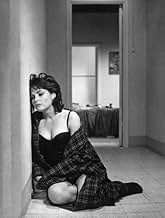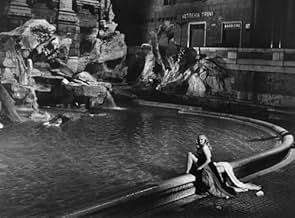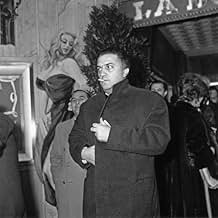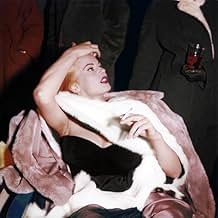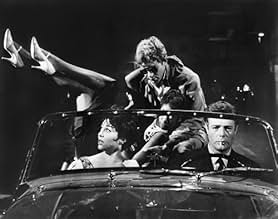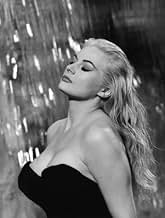Eine Reihe von Geschichten aus einer Woche im Leben eines flirtenden Boulevard-Journalisten in Rom.Eine Reihe von Geschichten aus einer Woche im Leben eines flirtenden Boulevard-Journalisten in Rom.Eine Reihe von Geschichten aus einer Woche im Leben eines flirtenden Boulevard-Journalisten in Rom.
- 1 Oscar gewonnen
- 11 Gewinne & 12 Nominierungen insgesamt
Anouk Aimée
- Maddalena
- (as Anouk Aimee)
Magali Noël
- Fanny
- (as Magali Noel)
Zusammenfassung
Reviewers say 'La Dolce Vita' delves into themes of fame, decadence, and the superficiality of celebrity culture, using these characters to underscore the contrasts and contradictions within high society. The portrayal of it's characters enhances the film's satirical and critical perspective on the lifestyles and attitudes of the era, offering a nuanced commentary on the nature of fame and its impact on individuals and society.
Empfohlene Bewertungen
(first of all, sorry my poor english) Who, in this entire world, drunk as a horse in the middle of the night, never discovered the meaning of life, that it can be so easy and joyfull that hurts. This happens with a certain frequency. The big problem is, after all that, to face all the thoughts and conclusions in a sober monday morning, when everything is just real, concious and above all that sincere. This is the the big question and problem of Marcello Rubini, a reporter of a gossip magazines who has to deal with the fact that he tastes the same poison he spreads by leaving in a group of people which he sucks his living.
In a moment he is directing his papparazzi and, in the next, he is running away from them. He flows between all kinds of social circles and the only impression he gives is that it doesnt matter what kind of craziness you are getting into everything is a big cliché. From the mainstream world of a gorgeous actress who feels able to express opinions about everything (and we buy it), passing throught the religious world of the faith, and also an intellectual circle that gives a fake impression of freedom, everything turns out to be an escape. That blonde girl appears as a stroke of pureness and sincereness, something we should really look for, but we just dont. In the case of Marcello's life, writing is the solutions he always substitute for vain experiences. Something he likes and that he needs a young girl to tell him that. That litlle cute girl is a person Marcello would like to be, someone who faces the soberty of a monday morning with hopeness and happiness.
A masterpiece.
In a moment he is directing his papparazzi and, in the next, he is running away from them. He flows between all kinds of social circles and the only impression he gives is that it doesnt matter what kind of craziness you are getting into everything is a big cliché. From the mainstream world of a gorgeous actress who feels able to express opinions about everything (and we buy it), passing throught the religious world of the faith, and also an intellectual circle that gives a fake impression of freedom, everything turns out to be an escape. That blonde girl appears as a stroke of pureness and sincereness, something we should really look for, but we just dont. In the case of Marcello's life, writing is the solutions he always substitute for vain experiences. Something he likes and that he needs a young girl to tell him that. That litlle cute girl is a person Marcello would like to be, someone who faces the soberty of a monday morning with hopeness and happiness.
A masterpiece.
LA DOLCE VITA presents a series of incidents in the life of Roman tabloid reporter Marcello Rubini (Marcello Mastroianni)--and although each incident is very different in content they create a portrait of an intelligent but superficial man who is gradually consumed by "the sweet life" of wealth, celebrity, and self-indulgence he reports on and which he has come to crave.
Although the film seems to be making a negative statement about self-indulgence that leads to self-loathing, Fellini also gives the viewer plenty of room to act as interpreter, and he cleverly plays one theme against its antithesis throughout the film. (The suffocation of monogamy vs. the meaninglessness of promiscuity and sincere religious belief vs. manipulative hypocrisy are but two of the most obvious juxtapositions.) But Fellini's most remarkable effect here is his ability to keep us interested in the largely unsympathetic characters LA DOLCE VITA presents: a few are naive to the point of stupidity; most are vapid; the majority (including the leads) are unspeakably shallow--and yet they still hold our interest over the course of this three hour film.
The cast is superior, with Marcello Mastroianni's personal charm particularly powerful. As usual with Fellini, there is a lot to look at on the screen: although he hasn't dropped into the wild surrealism for which he was sometimes known, there are quite a few surrealistic flourishes and visual ironies aplenty--the latter most often supplied by the hordes of photographers that scuttle after the leading characters much like cockroaches in search of crumbs. For many years available to the home market in pan-and-scan only, the film is now in a letterbox release that makes it all the more effective. Strongly recommended.
Gary F. Taylor, aka GFT, Amazon Reviewer
Although the film seems to be making a negative statement about self-indulgence that leads to self-loathing, Fellini also gives the viewer plenty of room to act as interpreter, and he cleverly plays one theme against its antithesis throughout the film. (The suffocation of monogamy vs. the meaninglessness of promiscuity and sincere religious belief vs. manipulative hypocrisy are but two of the most obvious juxtapositions.) But Fellini's most remarkable effect here is his ability to keep us interested in the largely unsympathetic characters LA DOLCE VITA presents: a few are naive to the point of stupidity; most are vapid; the majority (including the leads) are unspeakably shallow--and yet they still hold our interest over the course of this three hour film.
The cast is superior, with Marcello Mastroianni's personal charm particularly powerful. As usual with Fellini, there is a lot to look at on the screen: although he hasn't dropped into the wild surrealism for which he was sometimes known, there are quite a few surrealistic flourishes and visual ironies aplenty--the latter most often supplied by the hordes of photographers that scuttle after the leading characters much like cockroaches in search of crumbs. For many years available to the home market in pan-and-scan only, the film is now in a letterbox release that makes it all the more effective. Strongly recommended.
Gary F. Taylor, aka GFT, Amazon Reviewer
When it comes to art, the best one can do is receive it with grace, measure it against one's soul and if one is so inclined, speak from the heart about it. That's the only thing that matters, all else falling away. Comments about the execution are irrelevant, really. If someone talks about that, it isn't from their heart and doesn't really matter. This is excellently executed, but with art the only demand is that it cross a threshold of competence, making it close enough for us to reach. All else is decoration. Read elsewhere for comments on the decorative qualities of this.
I'll start from the end. I recommend you see this because it is a necessary launching ramp for "8 1/2." I believe that film is essential viewing for any citizen of the world, and to get it, you have to sit through this. Its roughly the same shape: Fellini himself, an empty and artless man posing as an artist who can only place himself in a definition of emptiness defined by the seven types of women.
In this world a convincing one women define the world by their being, and all spaces physical spaces I mean are carried by them into existence. Men merely stand between surrounding walls and the woman who made them whether she is present or not. When strained through the cloth of cinema, we have something like this film. (I wish some Japanese filmmaker would do for this what "H Story" did to "Hiroshima Mon Amore" but in Barcelona.)
So it is a competent film, even decorative. It is art, and for reasons beyond itself, you should see it.
But it doesn't measure well against my soul. Nor famously did it against Fellini's, which is why, after a celebrated crisis, he developed a different style for his next films. I suppose it is true that you could see this as about the bankruptcy of Roman aristocrats, or about more general bankruptcy of men. But I see it as about Fellini's own self inflicted, selfaware malaise.
But why is this one recommended to be rejected and the later one valued? Because of the cinematic form, dear friends. That's all that matters. Usually this form is considered realistic or neorealistic and the later films fantastic surreal. I think we can do better than that. The "neorealistic" films are composed by a self that stands outside. It sees and reports. It sees and judges; this is a film that assumes judgment. Its an essay, "explained" because both the filmmaker and the viewer stand outside it. Even the edges of the frame are perfectly placed, so as to remind us of the window we peer through.
"8 1/2" and his other project I admire ("Block-notes di un regista") have the filmmaker distinctly in the thing. The edges shift. We are invited in. Some things aren't clear, what we encounter hasn't been filtered to make sense for us. Its a party, but not one the camera understands, so we are in the midst of the battle instead of observing the party.
So if it is art you come for, you won't find it here unless you think competent decoration and impressive effect matter. What matters is whether the artist's blood mingles with ours, and Fellini didn't bleed until after this, probably because of this. Later, he did add that girl at the beach so his types of women total 8. I suppose you need to see this, then "8 1/2," then Greenaway's "8 1/2 Women."
It may not be the best way to capture a film, by bracketing it somehow. But it works for me in this case. This is just a bracket.
+++++++
One could say things about many of the characters and performances, and I cannot resist mentioning one: Nico. In the next to last segment, she plays a top model engaged to a royal nitwit. We gather at his castle and go ghost-hunting where we are given the woman-outside- the-walls story. This was when she really was a top model and before she became Andy Warhol's primary avatar in the world. She originated the "Gothic" look copied by millions of girl misfits. She reinvented a form of sultry singing (then newly in rock) that turns the notion of this movie inside out: deliberately soulless and therefore attractive.
This film also brackets her amazing glow as the Chelsea Girl. THE Chelsea Girl.
You should know about her. She had a real life. We all live in the ashes, unbeknownst.
Ted's Evaluation -- 3 of 3: Worth watching.
I'll start from the end. I recommend you see this because it is a necessary launching ramp for "8 1/2." I believe that film is essential viewing for any citizen of the world, and to get it, you have to sit through this. Its roughly the same shape: Fellini himself, an empty and artless man posing as an artist who can only place himself in a definition of emptiness defined by the seven types of women.
In this world a convincing one women define the world by their being, and all spaces physical spaces I mean are carried by them into existence. Men merely stand between surrounding walls and the woman who made them whether she is present or not. When strained through the cloth of cinema, we have something like this film. (I wish some Japanese filmmaker would do for this what "H Story" did to "Hiroshima Mon Amore" but in Barcelona.)
So it is a competent film, even decorative. It is art, and for reasons beyond itself, you should see it.
But it doesn't measure well against my soul. Nor famously did it against Fellini's, which is why, after a celebrated crisis, he developed a different style for his next films. I suppose it is true that you could see this as about the bankruptcy of Roman aristocrats, or about more general bankruptcy of men. But I see it as about Fellini's own self inflicted, selfaware malaise.
But why is this one recommended to be rejected and the later one valued? Because of the cinematic form, dear friends. That's all that matters. Usually this form is considered realistic or neorealistic and the later films fantastic surreal. I think we can do better than that. The "neorealistic" films are composed by a self that stands outside. It sees and reports. It sees and judges; this is a film that assumes judgment. Its an essay, "explained" because both the filmmaker and the viewer stand outside it. Even the edges of the frame are perfectly placed, so as to remind us of the window we peer through.
"8 1/2" and his other project I admire ("Block-notes di un regista") have the filmmaker distinctly in the thing. The edges shift. We are invited in. Some things aren't clear, what we encounter hasn't been filtered to make sense for us. Its a party, but not one the camera understands, so we are in the midst of the battle instead of observing the party.
So if it is art you come for, you won't find it here unless you think competent decoration and impressive effect matter. What matters is whether the artist's blood mingles with ours, and Fellini didn't bleed until after this, probably because of this. Later, he did add that girl at the beach so his types of women total 8. I suppose you need to see this, then "8 1/2," then Greenaway's "8 1/2 Women."
It may not be the best way to capture a film, by bracketing it somehow. But it works for me in this case. This is just a bracket.
+++++++
One could say things about many of the characters and performances, and I cannot resist mentioning one: Nico. In the next to last segment, she plays a top model engaged to a royal nitwit. We gather at his castle and go ghost-hunting where we are given the woman-outside- the-walls story. This was when she really was a top model and before she became Andy Warhol's primary avatar in the world. She originated the "Gothic" look copied by millions of girl misfits. She reinvented a form of sultry singing (then newly in rock) that turns the notion of this movie inside out: deliberately soulless and therefore attractive.
This film also brackets her amazing glow as the Chelsea Girl. THE Chelsea Girl.
You should know about her. She had a real life. We all live in the ashes, unbeknownst.
Ted's Evaluation -- 3 of 3: Worth watching.
Mostly because of the terrific high contrast, B&W visuals, and the evocative music, this is the only Fellini film I have seen that I have somewhat enjoyed. I recommend it, but not without reservations. It's a complex film with many textured layers of meaning. And, in typical Fellini fashion, it rambles and it meanders.
Deviating from standard three-Act structure, Fellini's story consists of roughly eight episodes, all starting at night and ending at dawn, more or less. Each has its own crisis. And the only thing that unites these episodes into a coherent whole is the story's protagonist, Marcello (Marcello Mastroianni). In his job as a journalist and overall observer of human nature, Marcello encounters people in high society who seem outwardly happy and self-fulfilled. On closer examination, however, these people are empty, hollow, alienated, emotionally adrift and vacant.
A good example is the starlet Sylvia (Anita Ekberg), a glamorous figure, but she's all image and no substance. "La dolce vita" is the first film that uses the concept of "paparazzi", which implies the importance of "image", separate from substance.
Throughout the various episodes Marcello sees these "images" of happiness, of contentment, but the images are deceptive, elusive, unreliable. In one episode, two "miracle" children "see" the Madonna. "The Madonna is over there", shouts one child. The crowd chases after her. But the other child who "sees" the Madonna runs in the opposite direction. Happiness, self-fulfillment, religious visions ... they're all a will-o'-the-wisp. And so, the film conveys a sense of pessimism and cynicism.
The film thus has deep thematic value. It caused a scandal when it was released, and was banned by the Catholic Church, apparently for appearing to be anti-religious.
Yet for all its deep meaning, "La dolce vita" can be a trial to sit through. Somewhere in the second half I began to lose interest. I don't have a problem with Fellini's deviation from standard plot structure. I do have a problem with a director who doesn't know when to quit. This film goes on for almost three hours. A good edit, to delete all the fat, would have tightened up the story and rendered it more potent. As is, it's too strung out, too stretched, too meandering.
If the viewer can persevere, there's enormous cinematic art in this film. And helped along by Nino Rota's music, the film is wonderfully evocative, at times stylishly melancholy.
Deviating from standard three-Act structure, Fellini's story consists of roughly eight episodes, all starting at night and ending at dawn, more or less. Each has its own crisis. And the only thing that unites these episodes into a coherent whole is the story's protagonist, Marcello (Marcello Mastroianni). In his job as a journalist and overall observer of human nature, Marcello encounters people in high society who seem outwardly happy and self-fulfilled. On closer examination, however, these people are empty, hollow, alienated, emotionally adrift and vacant.
A good example is the starlet Sylvia (Anita Ekberg), a glamorous figure, but she's all image and no substance. "La dolce vita" is the first film that uses the concept of "paparazzi", which implies the importance of "image", separate from substance.
Throughout the various episodes Marcello sees these "images" of happiness, of contentment, but the images are deceptive, elusive, unreliable. In one episode, two "miracle" children "see" the Madonna. "The Madonna is over there", shouts one child. The crowd chases after her. But the other child who "sees" the Madonna runs in the opposite direction. Happiness, self-fulfillment, religious visions ... they're all a will-o'-the-wisp. And so, the film conveys a sense of pessimism and cynicism.
The film thus has deep thematic value. It caused a scandal when it was released, and was banned by the Catholic Church, apparently for appearing to be anti-religious.
Yet for all its deep meaning, "La dolce vita" can be a trial to sit through. Somewhere in the second half I began to lose interest. I don't have a problem with Fellini's deviation from standard plot structure. I do have a problem with a director who doesn't know when to quit. This film goes on for almost three hours. A good edit, to delete all the fat, would have tightened up the story and rendered it more potent. As is, it's too strung out, too stretched, too meandering.
If the viewer can persevere, there's enormous cinematic art in this film. And helped along by Nino Rota's music, the film is wonderfully evocative, at times stylishly melancholy.
Marcello Rubini (Marcello Mastroianni) is a man-about-town and a gossip journalist in Rome. His girlfriend Emma overdoses and recovers. Swedish-American bombshell Sylvia (Anita Ekberg) arrives and hangs out with Marcello while the Paparazzo hounds them. Her boyfriend Robert gets angry and hits him. As his series of adventures continue, there is an emptiness to it all and a meaninglessness to his life.
This iconic film has a disjointed narrative structure. It has many sections without the connective tissue. It's a tough watch especially for a three hour movie. It's exhilarating for a long time but it gets tiring by the end. The sad emptiness infects the viewing experience. The lifestyle is thoroughly modern celebrity world. The thrill disapates. Its iconic nature deserves extra points, but this is strictly for film fans.
This iconic film has a disjointed narrative structure. It has many sections without the connective tissue. It's a tough watch especially for a three hour movie. It's exhilarating for a long time but it gets tiring by the end. The sad emptiness infects the viewing experience. The lifestyle is thoroughly modern celebrity world. The thrill disapates. Its iconic nature deserves extra points, but this is strictly for film fans.
Wusstest du schon
- WissenswertesThe famous scene in the Trevi Fountain was shot over a week in March, when nights were still cold. According to Federico Fellini (in an interview with Costanzo Costantini), Anita Ekberg stood in the cold water in her dress for hours with no trouble. Marcello Mastroianni, on the other hand, had to wear a wetsuit beneath his clothes, and even that wasn't enough. Still freezing, he downed an entire bottle of vodka, so he was completely drunk while shooting the scene.
- PatzerWhen Marcello and Maddalena arrive at the prostitute's apartment, a long electric cable (light?) can be seen attached to the right rear of the car, moving along until the car stops.
- Alternative VersionenIn the original American release, distributed by American International Pictures, the titles open with the AIP logo and appear over a shot of the sky with clouds. In the current release on DVD - and as shown on TCM - the title sequence is over a black background. When originally released, censors in several countries trimmed certain scenes, including the orgy near the end of the film.
- VerbindungenEdited into La case du siècle: Cinecittà, de Mussolini à la Dolce Vita (2021)
Top-Auswahl
Melde dich zum Bewerten an und greife auf die Watchlist für personalisierte Empfehlungen zu.
Details
- Erscheinungsdatum
- Herkunftsländer
- Offizieller Standort
- Sprachen
- Auch bekannt als
- La dulce vida
- Drehorte
- Villa Giustiniani-Odescalchi, Bassano Romano, Viterbo, Lazio, Italien(abandoned castle scenes)
- Produktionsfirmen
- Weitere beteiligte Unternehmen bei IMDbPro anzeigen
Box Office
- Weltweiter Bruttoertrag
- 217.420 $
- Laufzeit2 Stunden 54 Minuten
- Farbe
- Seitenverhältnis
- 2.35 : 1
Zu dieser Seite beitragen
Bearbeitung vorschlagen oder fehlenden Inhalt hinzufügen


![Trailer [English SUB] ansehen](https://m.media-amazon.com/images/M/MV5BNjE3MTU3OTItN2I0NS00YzU2LWE1ZTctZDQ3Y2I1NDc4MGMxXkEyXkFqcGdeQXRyYW5zY29kZS13b3JrZmxvdw@@._V1_QL75_UX500_CR0)
![La Dolce Vita: [2-Disc Collectors Edition]](https://m.media-amazon.com/images/M/MV5BZTY2ZTg3YmEtZDZkMS00MmFkLThhMjItMWVmN2NlNmJhZGZjXkEyXkFqcGdeQXVyNzU1NzE3NTg@._V1_QL75_UX500_CR0)

